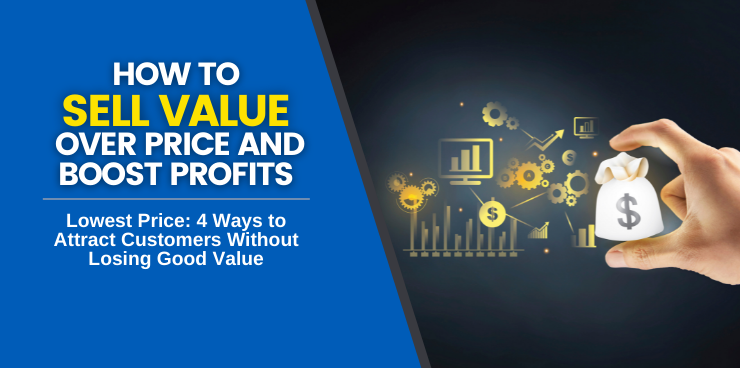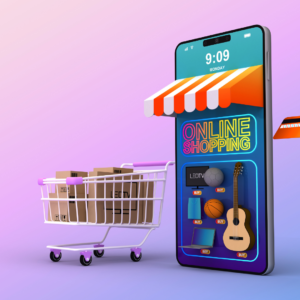As a business owner, by now you know that leads are not all created equal.
Converting leads is no easy feat, and even the most established companies struggle to turn their leads into loyal tribe members and advocates for their brand.
Their “lowest price” offers aren’t producing the profits they’ve hoped for, and it leaves them stumped on where to turn next.
What these companies don’t realize is, is that the moment you advertise a discount, rebate, coupon, or sale you make your customer’s price sensitive.
All of them… including those who weren’t!
So how do we solve this? How do we increase our close rate and improve our profitability without making our prospects price sensitive?
In this article, we’ll go over how having the lowest prices isn’t always a good thing, and what you can do to increase your profits.
Does Lowest Price Mean Good Value or Poor Quality?
It’s true, there’s a whole lot of hype around a great deal. But cheaper isn’t always necessarily better. You know the phrase: “you get what you pay for.”
A study from Vanderbilt University suggests that low prices can completely backfire because they may be associated with poorer quality.
At the end of the day, most customers really want good value.
When you can take a great product or service and turn it into a no-brainer without dropping a penny off the price, you get the same response as a discount, without the price sensitivity.
It can be a tricky balance to strike, but it’s worth taking the time to figure it out. After all, no one wants to be known as the brand that offers the lowest quality at the lowest price.
At Wizard of Sales®, we can help you create a pricing strategy that will increase sales and boost profits. If you need help maximizing the value of your products and services, book a demo with us today.
Why Shouldn’t You Go for Lowest Pricing?
When you are selling your products or services, it is important to remember that lowest prices aren’t always the best prices. There are a few reasons why this is the case:
It attracts a poorer quality clientele
If you are constantly undercutting your competition, it will send the message that you are not a high-quality business. This can lead to attracting lower-quality clients who are only interested in getting the lowest price, rather than receiving quality products or services.
It makes high quality prospects suspicious
On the other hand, if you are too focused on selling at the lowest price, you may inadvertently drive away prospective high-paying customers. These prospects may price compare with your competitors and feel that your business is not worth their time and money. If you are not able to command a higher price point that reflects the quality of your products or services, chances are they’ll look elsewhere. This is especially true of the busy clientele who are looking for it to get done right the first time and not be a nuisance in the foreseeable future.
It will attract clients who are willing to push the boundaries
If you are constantly selling at the lowest price, you will likely attract clients who are always looking for a bargain and are willing to push the boundaries in order to get the lowest price possible. This can be detrimental to your business in the long run, as these types of clients can take up a lot of your time and energy without providing much in return.
You may get less commitment from your clientele
In many cases, the lowest price is associated with a lower quality product or service. As a result, your clientele may not be as committed to using your products or services if they feel that they are of lower quality. This can lead to less repeat business and fewer referrals, which hurt your bottom line.
How to Attract the Transactional Customers Who Are Looking to do Nothing More Than Get the Lowest Price?
So how do you attract transactional customers who are looking to do nothing more than getting the lowest price?
With relational-friendly transactional offers! Here are some great examples that are sure to increase your conversion rate and order value.
 Feature item
Feature item
Feature items are usually products or services that are only available for a limited time or in a limited quantity. This makes them a great way to get people in the door who might not normally consider your business.
Unlike featuring discounted items that might lose you money, these types of feature items can be set at their valued price as they are only available for a limited time. This encourages people to buy them while they’re available, instead of waiting to see if the price goes down.
Take Google shopping, for instance, their home page is constantly featuring different items on their Google shopping list that are only available for a limited time. This helps to increase traffic to their site and encourages people to buy.
Of course, you don’t want to overdo it with featured items or you’ll end up devaluing your brand. Choose items that are high quality and that you think will appeal to your target market. Then, promote them in a way that makes sense for your business. This could be through social media, email marketing, or even leaving behind a surprise coupon reward after completing a job.
Gift with purchase
Another genius way to satisfy transactional customers is by providing a gift with purchase. This is when customers are given a freebie after they buy a certain product.
Gift with purchase gives those customers who are wary to spend the big bucks just enough push to buy. It justifies that even though they are spending a bit more than they want to, at least they are getting something else valuable for free.
Gift with purchase is a cost-effective way to increase sales while still being able to keep your desired price points without devaluing your brand. Why? Because while the retail value of say, a box of filters may be $120, you could provide a year’s worth of filters with every tune-up at a hard cost of $30. Plus, these gifts are usually exclusive and limited so it adds a sense of urgency for customers to buy.
Gift with appointment
Similar to gift with purchase, gift with appointment is a marketing strategy in which stores offer customers a free gift if they agree to schedule an appointment. The appointment can be for anything, from a free estimate to preventative maintenance.
The main goal of the appointment is to give your customers a first taste of your brand, while the main goal of the gift is to elicit a positive association with your brand. This will effectively help build relationships with your customers so they’ll become loyal to your tribe.
Gift with appointment can be very effective, especially if the free gift is something that the customer really wants. However, it’s important to make sure that the appointment is not too much of a hassle for the customer, or they may not bother showing up.
Consider this. You offer a $93 or its free drain clearing, knowing that 75% of these clogs can be cleared with a 30 ft snake and a rookie with a good attitude and a clear out drain. But what if you also offered a free video inspection (150 retail value) with every clogged drain? Would this add value to your service? Would you also be afforded the opportunity to uncover the bigger job?
It’s not what you say, it’s how you say it.
 Value add bundles
Value add bundles
Value add bundles are when a company offers a product or service at a discounted price when another product or service is also purchased.
This is a strategy that convinces customers who want to spend the lowest price to buy. By bundling products together, companies can increase the perceived value of their products and services. Customers are more likely to purchase a bundle if they feel that they are getting a good deal compared to competitor brands.
Value add bundles can be an effective way to increase sales and improve customer satisfaction. However, it is important to make sure that the products in the bundle are actually valuable to the customer. Otherwise, you may end up losing money on the deal.
Self-Imposed Consequences
When you are willing to impose a consequence on yourself when you are generating leads, this is a signal to your prospects that you are trustworthy and dependable.
For example, if you offered same day service, or the call is free, you would dramatically increase your demand service business by putting your money where your mouth is. Now I’m not talking about just waiving the diagnostic fee or trip fee. No. I’m talking the entire service call, parts and labor included.
You see, nobody cares that you got busy. Nobody in the history of homes has wanted to deal with an unexpected plumbing or temperature issue. So they want it handled quickly. For the large quantity of undecided shoppers, this strong signal of trust tells them that you are the right company to take a gamble on.
Extraordinary Value IS Spendable
We hope that our deep dive analysis has shown you that lowest price offers are more likely to lose, yes LOSE, you money in the long run.
Don’t be seduced by coupons, discounts, rebates, and sales.
Instead, hone in on what value you’re showcasing to your customers. Provide top-tier quality, customer service, and convenience and you’ll reap the rewards in spades.
What’s the use in offering the lowest price if it means you’re going to lose money in the long run? It’s NOT worth it! Instead, focus on providing value to your customers in the form of quality solutions.
At Wizard of Sales®, we help provide extraordinary value that gets people to try what you have to offer while delivering a quick, simple, and safe experience with a dollop of delight at the end.
To see your revenue not only meet but exceed your expectations, book a demo with us today!



 Feature item
Feature item Value add bundles
Value add bundles